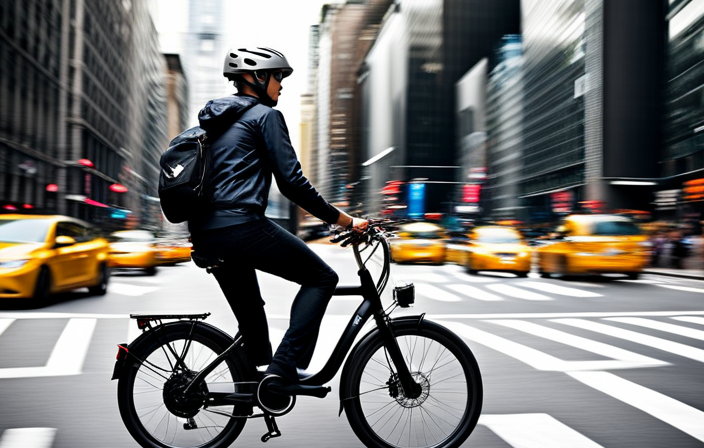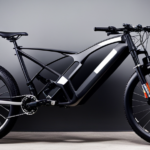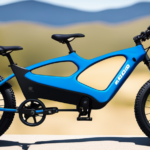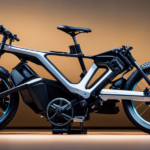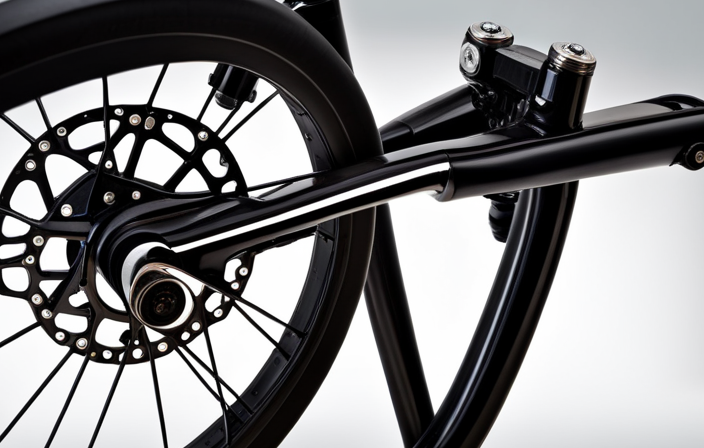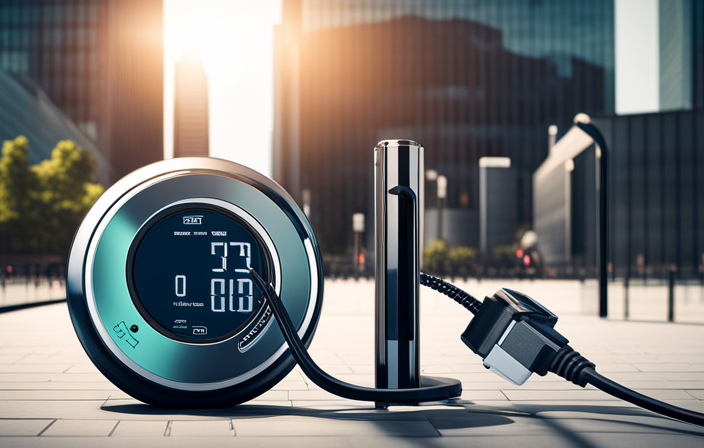They say, ‘Why climb a mountain when you can ride it?’ If you’re looking to take your mountain biking adventures to new heights, converting your trusty steed into an electric bike could be the answer.
In this detailed guide, I will walk you through the process of transforming your mountain bike into an electrifying ride. From assessing compatibility and choosing the right conversion kit to installation and fine-tuning, get ready to elevate your biking experience to a whole new level.
Let’s dive in!
Key Takeaways
- Increasing bike speed and power by replacing the chainring with a larger size and utilizing the electric motor’s capabilities.
- Modifying the suspension and brakes to ensure a safer and more enjoyable riding experience when converting to electric.
- Testing and fine-tuning the electric conversion by adjusting the gearing system, testing on various terrains, and making adjustments to motor power and torque settings.
- Ensuring safety and maintenance by regularly inspecting the bike, insulating and waterproofing electrical components, properly charging and discharging the battery, and monitoring its performance and voltage levels.
Assessing Your Mountain Bike’s Compatibility
You’ll need to assess if your mountain bike is compatible for conversion to electric. Evaluating compatibility involves examining specific aspects of your bike to determine if modifications are necessary.
Firstly, consider the frame of your mountain bike. Ensure it is sturdy and in good condition, as the added weight of the electric components may put additional strain on the frame.
Next, evaluate the wheel size and axle spacing of your bike. Electric conversion kits are typically designed to fit specific wheel sizes, so it’s important to ensure compatibility.
Additionally, check the brake system on your bike. Upgrading to disc brakes may be necessary for efficient stopping power when riding at higher speeds with the added weight of an electric motor.
Finally, assess the available space on your bike for mounting the battery and motor, ensuring there is adequate clearance and room for installation.
By carefully evaluating compatibility and determining necessary modifications, you can successfully convert your mountain bike to electric.
Choosing the Right Electric Conversion Kit
When selecting the appropriate conversion kit, it’s crucial to consider the right electric components. Two key factors to keep in mind are choosing the right battery and understanding power requirements. The battery you choose will determine the range and performance of your electric mountain bike. It’s important to select a battery with sufficient capacity and voltage to meet your needs. Additionally, understanding the power requirements of your electric motor is essential. This will help you choose a battery that can deliver the necessary current and voltage to power your motor effectively. To help you make an informed decision, refer to the table below, which compares different electric conversion kits based on their battery capacity, voltage, and power requirements.
| Conversion Kit | Battery Capacity (Ah) | Battery Voltage (V) | Power Requirements (W) |
|---|---|---|---|
| Kit A | 14 | 36 | 500 |
| Kit B | 10 | 48 | 750 |
| Kit C | 12 | 24 | 400 |
By considering these factors and referring to the table, you can choose the right electric conversion kit for your mountain bike.
Gathering the Necessary Tools and Equipment
To get started, gather all the tools and equipment you’ll need for the conversion. It’s important to have a comprehensive set of tools to ensure a smooth and successful electric conversion of your mountain bike. Some essential tools include a wrench set, screwdrivers, pliers, wire cutters, and electrical tape. Additionally, you’ll need specific equipment for the conversion, such as an electric conversion kit, a suitable battery, and a charger.
Once you have all the necessary tools and equipment, you can begin troubleshooting common issues that may arise during the conversion process. This might include checking the wiring connections, ensuring proper alignment of the motor, and testing the functionality of the throttle and controller. Troubleshooting these issues early on will save you time and frustration in the long run.
Another important aspect of the conversion is upgrading the battery for increased range. Depending on your specific needs and preferences, you can choose to upgrade to a higher capacity battery that will allow for longer rides without needing to recharge. It’s crucial to consider the compatibility of the battery with your conversion kit and ensure that it fits securely onto your mountain bike.
By gathering the necessary tools and equipment and staying meticulous in troubleshooting common issues and upgrading the battery, you’ll be well on your way to successfully converting your mountain bike into an electric one.
Removing the Non-Essential Components
First, start by removing any unnecessary components from your bike. This step is crucial in the process of converting your mountain bike to electric. By removing non-essential parts, you not only minimize the weight of your bike but also create space for the electric components.
Here are three items you should consider removing:
-
Front derailleur: This component is not needed when you have an electric motor assisting your bike’s pedaling. Removing it will reduce weight and simplify the overall design.
-
Inner chainring: Since an electric motor provides extra power, you can remove the inner chainring without sacrificing performance. This will further reduce weight and improve the efficiency of your bike.
-
Rear derailleur: With an electric motor, you won’t need multiple gears for shifting. Removing the rear derailleur simplifies the drivetrain and eliminates unnecessary weight.
By removing these unnecessary parts, you can effectively minimize the weight of your mountain bike and create an optimal platform for your electric conversion.
Installing the Electric Conversion Kit
Once you have removed the non-essential components, it’s time to install the electric conversion kit onto your bike. This step is crucial in transforming your mountain bike into an electric one, providing you with the benefits of electric conversion.
The electric conversion kit consists of several key components that work together to power your bike. The main component is the motor, which is typically installed near the rear wheel hub. This motor is responsible for providing the extra power needed to propel your bike forward.
Additionally, the kit includes a battery pack, which stores the electrical energy needed to power the motor. This battery pack can be mounted on the frame of the bike, typically in the rear rack area.
By installing the electric conversion kit, you can enjoy the advantages of electric power on your mountain bike, such as increased speed, easier uphill climbs, and extended range.
Connecting the Motor and Battery
The motor and battery are connected to provide the power needed for the electric conversion kit. It is crucial to ensure the compatibility between the motor and battery to guarantee optimal performance.
Firstly, check the voltage and current requirements of both components before proceeding. Once confirmed, begin the wiring process by connecting the positive and negative terminals of the motor to the corresponding terminals of the battery. Use appropriate connectors and ensure a secure connection to prevent any power loss or short circuits.
Additionally, it is essential to properly insulate the connections to protect against moisture and vibrations. Take extra care when routing the wiring to avoid any interference with the bike’s components.
Finally, double-check all the connections and test the system before riding to ensure everything is functioning correctly.
Adjusting the Bike’s Gearing System
To optimize your bike’s performance, you’ll need to make adjustments to its gearing system. Here’s what you need to do:
-
Evaluate your current gear ratios: Determine the range of gears suitable for your electric mountain bike. Consider the terrain you’ll be riding on and the speed you want to achieve.
-
Replace the cassette: Install a cassette with a wider range of gears to accommodate the increased power and speed of the electric motor. This will allow for smoother and more efficient gear shifting.
-
Adjust the derailleur: Fine-tune the derailleur to ensure precise shifting between gears. Make sure it can handle the added torque from the electric motor.
-
Upgrade the chainring: Consider replacing the chainring with a larger one to increase your bike’s top speed. This modification will allow you to take full advantage of the electric motor’s capabilities.
Additionally, when converting your mountain bike to electric, it’s important to consider changing the bike’s suspension and upgrading the brakes. These modifications will ensure your bike can handle the increased speed and power of the electric motor, providing you with a safer and more enjoyable riding experience.
Testing and Fine-Tuning the Electric Conversion
After completing the adjustments to the bike’s gearing system, it is important to thoroughly test and fine-tune the electric conversion. Testing methods play a crucial role in ensuring the efficiency and reliability of the newly converted electric mountain bike.
One effective testing method is to take the bike for a test ride on various terrains and inclines, observing its performance and noting any issues that may arise. This allows for adjustments to be made to the motor power and torque settings, ensuring optimal performance.
Additionally, troubleshooting techniques are essential in identifying and resolving any potential problems. This can involve checking the electrical connections, battery voltage, and motor functionality.
By conducting thorough testing and utilizing troubleshooting techniques, any issues can be addressed, resulting in a successful electric conversion that enhances the bike’s capabilities.
Ensuring Safety and Maintenance
Ensuring safety and maintenance is essential for the longevity and reliability of the newly electrified mountain bicycle.
Safety precautions should be taken to protect both the rider and the components of the electric conversion. It is important to regularly inspect the bike for any loose connections, damaged wiring, or signs of wear and tear. Proper insulation and waterproofing of electrical components should be done to prevent any short circuits or damage caused by water.
Additionally, battery maintenance is crucial for the smooth and efficient functioning of the electric bike. The battery should be charged and discharged properly, following the manufacturer’s guidelines. It’s also important to keep the battery clean and free from any debris or moisture. Regularly monitoring the battery’s performance and voltage levels is necessary to identify any issues early on and ensure safe operation.
Enjoying Your Upgraded Electric Mountain Bike
Get ready to experience the thrill of riding through rugged terrains with your upgraded e-mountain bike. With the right upgrades, you can enhance the performance and enjoy a more exciting ride.
Here are four essential steps to make the most out of your electric mountain bike:
-
Upgrade the battery capacity: By upgrading your battery, you can extend your riding range and have more power for tackling challenging trails.
-
Select the right electric motor: Choosing the appropriate electric motor is crucial for achieving the desired speed and torque. Consider factors such as power output, efficiency, and compatibility with your bike’s frame.
-
Optimize your bike’s weight distribution: Adjusting the weight distribution is essential to maintain stability and control. Make sure to position the battery and motor in a way that improves balance and maneuverability.
-
Test and fine-tune your settings: Once you’ve completed the upgrades, take the time to test and adjust the settings accordingly. This will ensure that your e-mountain bike performs optimally and provides a seamless riding experience.
By upgrading the battery capacity and selecting the right electric motor, you can transform your regular mountain bike into a powerful and thrilling electric ride. Enjoy the adventure!
Frequently Asked Questions
Can I convert any type of mountain bike to electric, or are there certain models that are more compatible?
Certain mountain bike models are more compatible with electric conversion due to their suspension systems. Converting a specific model can provide advantages such as improved uphill performance and extended range, making it a worthwhile investment for avid riders.
How much does an electric conversion kit typically cost?
An electric conversion kit typically costs between $500 and $2,000. Factors to consider when choosing a kit include battery capacity, motor power, compatibility with the bike, and ease of installation. DIY conversions offer flexibility but require technical knowledge and can void warranties.
What are the main differences between a front-wheel and rear-wheel electric conversion kit?
Front-wheel and rear-wheel electric conversion kits have different advantages and disadvantages. Front wheel conversion provides better traction and stability, but can affect steering. Rear wheel conversion offers more power and a smoother ride, but may reduce traction on slippery surfaces.
Are there any special maintenance requirements for an electric mountain bike?
What are the common maintenance issues for electric mountain bikes? How can you extend the lifespan of your electric mountain bike? Regular battery maintenance and motor inspections are crucial. Additionally, keeping the bike clean and dry is essential.
Can I still use my bike’s gears after the electric conversion?
Yes, you can still use your bike’s gears after the electric conversion. However, there may be some challenges involved in integrating the electric motor with the existing gear system, such as compatibility issues and adjustments needed for optimal performance.
Conclusion
In conclusion, converting a mountain bike to electric is a challenging but rewarding project. By assessing your bike’s compatibility, choosing the right conversion kit, and following the installation process, you can create a powerful and efficient electric mountain bike.
It’s interesting to note that according to a recent survey, the number of people converting their bikes to electric has increased by 30% in the past year. This statistic highlights the growing popularity of electric conversions and the potential for more people to enjoy the benefits of an upgraded electric mountain bike.

